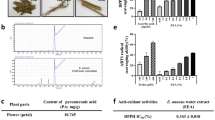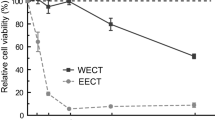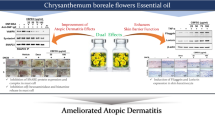Abstract
Background
Chimpi, the dried peel of Citrus unshiu or Citrus reticulata, has various pharmacological effects. Chimpi extract was recently shown to affect the skin, including its inhibitory effect against atopic dermatitis. In this study, we analyzed the effects of Chimpi extract on the functional molecule aquaporin-3 (AQP3), which is involved in water transport and cell migration in the skin.
Methods and Results
Chimpi extract was added to HaCaT human skin keratinocytes, and the AQP3 expression level was analyzed. A wound healing assay was performed to evaluate the effect of Chimpi extract on cell migration. The components of Chimpi extract and fractions obtained by liquid–liquid distribution studies were added to HaCaT cells, and AQP3 expression was analyzed. Chimpi extract significantly increased AQP3 expression in HaCaT cells at both the mRNA and protein levels. Immunocytochemical staining revealed that Chimpi extract also promoted the transfer of AQP3 to the cell membrane. Furthermore, Chimpi extract enhanced cell migration. Hesperidin, narirutin, and nobiletin did not increase AQP3 levels. Although the components contained in the fractions obtained from the chloroform, butanol, and water layer increased AQP3, the active components could not be identified.
Conclusions
These results reveal that Chimpi extract may increase AQP3 levels in keratinocytes and increase the dermal water content. Therefore, Chimpi extract may be effective for the management of dry skin.





Similar content being viewed by others
References
Kim A, Im M, Gu MJ, Ma JY (2016) Citrus unshiu peel extract alleviates cancer-induced weight loss in mice bearing CT-26 adenocarcinoma. Sci Rep 6:24214. https://doi.org/10.1038/srep24214
Ito A, Shin N, Tsuchida T, Okubo T, Norimoto H (2013) Antianxiety-like effects of Chimpi (dried citrus peels) in the elevated open-platform test. Molecules 18:10014–10023. https://doi.org/10.3390/molecules180810014
Kang GJ, Han SC, Yi EJ, Kang HK, Yoo ES (2011) The inhibitory effect of premature citrus unshiu extract on atopic dermatitis in vitro and in vivo. Toxicol Res 27:173–180. https://doi.org/10.5487/TR.2011.27.3.173
Park SH, Park EK, Kim DH (2005) Passive cutaneous anaphylaxis-inhibitory activity of flavanones from Citrus unshiu and Poncirus trifoliata. Planta Med 71:24–27. https://doi.org/10.1055/s-2005-837746
Choi SH, Choi SI, Jung TD, Cho BY, Lee JH, Kim SH, Yoon SA, Ham YM, Yoon WJ, Cho JH, Lee OH (2017) Anti-photoaging effect of Jeju putgyul (Unripe Citrus) extracts on human dermal fibroblasts and ultraviolet B-induced hairless mouse skin. Int J Mol Sci. https://doi.org/10.3390/ijms18102052
Bae JT, Ko HJ, Kim GB, Pyo HB, Lee GS (2012) Protective effects of fermented Citrus unshiu peel extract against ultraviolet-A-induced photoageing in human dermal fibrobolasts. Phytother Res 26:1851–1856. https://doi.org/10.1002/ptr.4670
Kim C, Ji J, Ho Baek S, Lee JH, Ha IJ, Lim SS, Yoon HJ, Je Nam Y, Ahn KS (2019) Fermented dried Citrus unshiu peel extracts exert anti-inflammatory activities in LPS-induced RAW264.7 macrophages and improve skin moisturizing efficacy in immortalized human HaCaT keratinocytes. Pharm Biol 57:392–402. https://doi.org/10.1080/13880209.2019.1621353
Oliver N, Sternlicht M, Gerritsen K, Goldschmeding R (2010) Could aging human skin use a connective tissue growth factor boost to increase collagen content? J Invest Dermatol 130:338–341. https://doi.org/10.1038/jid.2009.331
Liu T, Li N, Yan YQ, Liu Y, Xiong K, Liu Y, Xia QM, Zhang H, Liu ZD (2020) Recent advances in the anti-aging effects of phytoestrogens on collagen, water content, and oxidative stress. Phytother Res 34:435–447. https://doi.org/10.1002/ptr.6538
Ghersetich I, Lotti T, Campanile G, Grappone C, Dini G (1994) Hyaluronic acid in cutaneous intrinsic aging. Int J Dermatol 33:119–122. https://doi.org/10.1111/j.1365-4362.1994.tb01540.x
Papakonstantinou E, Roth M, Karakiulakis G (2012) Hyaluronic acid: a key molecule in skin aging. Dermatoendocrinol 4:253–258. https://doi.org/10.4161/derm.21923
Li Q, Fang H, Dang E, Wang G (2020) The role of ceramides in skin homeostasis and inflammatory skin diseases. J Dermatol Sci 97:2–8. https://doi.org/10.1016/j.jdermsci.2019.12.002
Bollag WB, Aitkens L, White J, Hyndman KA (2020) Aquaporin-3 in the epidermis: more than skin deep. Am J Physiol Cell Physiol 318:C1144–C1153. https://doi.org/10.1152/ajpcell.00075.2020
Fujiyoshi Y, Mitsuoka K, de Groot BL, Philippsen A, Grubmuller H, Agre P, Engel A (2002) Structure and function of water channels. Curr Opin Struct Biol 12:509–515. https://doi.org/10.1016/s0959-440x(02)00355-x
Ma T, Hara M, Sougrat R, Verbavatz JM, Verkman AS (2002) Impaired stratum corneum hydration in mice lacking epidermal water channel aquaporin-3. J Biol Chem 277:17147–17153. https://doi.org/10.1074/jbc.M200925200
Hara M, Ma T, Verkman AS (2002) Selectively reduced glycerol in skin of aquaporin-3-deficient mice may account for impaired skin hydration, elasticity, and barrier recovery. J Biol Chem 277:46616–46621. https://doi.org/10.1074/jbc.M209003200
Hara-Chikuma M, Verkman AS (2008) Aquaporin-3 facilitates epidermal cell migration and proliferation during wound healing. J Mol Med (Berl) 86:221–231. https://doi.org/10.1007/s00109-007-0272-4
Spector DA, Wade JB, Dillow R, Steplock DA, Weinman EJ (2002) Expression, localization, and regulation of aquaporin-1 to -3 in rat urothelia. Am J Physiol Renal Physiol 282:F1034-1042. https://doi.org/10.1152/ajprenal.00136.2001
Umenishi F, Narikiyo T, Schrier RW (2005) Effect on stability, degradation, expression, and targeting of aquaporin-2 water channel by hyperosmolality in renal epithelial cells. Biochem Biophys Res Commun 338:1593–1599. https://doi.org/10.1016/j.bbrc.2005.10.127
Hendriks G, Koudijs M, van Balkom BW, Oorschot V, Klumperman J, Deen PM, van der Sluijs P (2004) Glycosylation is important for cell surface expression of the water channel aquaporin-2 but is not essential for tetramerization in the endoplasmic reticulum. J Biol Chem 279:2975–2983. https://doi.org/10.1074/jbc.M310767200
Baumgarten R, Van De Pol MH, Wetzels JF, Van Os CH, Deen PM (1998) Glycosylation is not essential for vasopressin-dependent routing of aquaporin-2 in transfected Madin-Darby canine kidney cells. J Am Soc Nephrol 9:1553–1559. https://doi.org/10.1681/ASN.V991553
Cao C, Sun Y, Healey S, Bi Z, Hu G, Wan S, Kouttab N, Chu W, Wan Y (2017) Correction: EGFR-mediated expression of aquaporin-3 is involved in human skin fibroblast migration. Biochem J 474:2901–2902. https://doi.org/10.1042/BCJ-2006-0816_COR
Sakaki M, Harai K, Takahashi R, Amitani M, Amitani H, Takimoto Y, Inui A (2021) Medicine and food with particular reference to chinpi, dried citrus peel, and a component of Ninjin’yoeito. Neuropeptides 89:102166. https://doi.org/10.1016/j.npep.2021.102166
Tsujimoto T, Arai R, Yoshitomi T, Yamamoto Y, Ozeki Y, Hakamatsuka T, Uchiyama N (2021) UHPLC/MS and NMR-based metabolomic analysis of dried water extract of Citrus-type crude drugs. Chem Pharm Bull (Tokyo) 69:741–746. https://doi.org/10.1248/cpb.c21-00180
Itoh K, Hirata N, Masuda M, Naruto S, Murata K, Wakabayashi K, Matsuda H (2009) Inhibitory effects of Citrus hassaku extract and its flavanone glycosides on melanogenesis. Biol Pharm Bull 32:410–415. https://doi.org/10.1248/bpb.32.410
Sasaki K, Yoshizaki F (2002) Nobiletin as a tyrosinase inhibitor from the peel of Citrus fruit. Biol Pharm Bull 25:806–808. https://doi.org/10.1248/bpb.25.806
Tanaka S, Sato T, Akimoto N, Yano M, Ito A (2004) Prevention of UVB-induced photoinflammation and photoaging by a polymethoxy flavonoid, nobiletin, in human keratinocytes in vivo and in vitro. Biochem Pharmacol 68:433–439. https://doi.org/10.1016/j.bcp.2004.04.006
Man G, Mauro TM, Zhai Y, Kim PL, Cheung C, Hupe M, Crumrine D, Elias PM, Man MQ (2015) Topical hesperidin enhances epidermal function in an aged murine model. J Invest Dermatol 135:1184–1187. https://doi.org/10.1038/jid.2014.486
Hou M, Man M, Man W, Zhu W, Hupe M, Park K, Crumrine D, Elias PM, Man MQ (2012) Topical hesperidin improves epidermal permeability barrier function and epidermal differentiation in normal murine skin. Exp Dermatol 21:337–340. https://doi.org/10.1111/j.1600-0625.2012.01455.x
Yoshizaki N, Fujii T, Masaki H, Okubo T, Shimada K, Hashizume R (2014) Orange peel extract, containing high levels of polymethoxyflavonoid, suppressed UVB-induced COX-2 expression and PGE2 production in HaCaT cells through PPAR-gamma activation. Exp Dermatol 23(Suppl 1):18–22. https://doi.org/10.1111/exd.12394
Jiang YJ, Kim P, Lu YF, Feingold KR (2011) PPARgamma activators stimulate aquaporin 3 expression in keratinocytes/epidermis. Exp Dermatol 20:595–599. https://doi.org/10.1111/j.1600-0625.2011.01269.x
Ikarashi N, Kon R, Kaneko M, Mizukami N, Kusunoki Y, Sugiyama K (2017) Relationship between Aging-related skin dryness and aquaporins. Int J Mol Sci. https://doi.org/10.3390/ijms18071559
Lee Y, Je YJ, Lee SS, Li ZJ, Choi DK, Kwon YB, Sohn KC, Im M, Seo YJ, Lee JH (2012) Changes in transepidermal water loss and skin hydration according to expression of aquaporin-3 in psoriasis. Ann Dermatol 24:168–174. https://doi.org/10.5021/ad.2012.24.2.168
Ikarashi N, Mizukami N, Pei C, Uchino R, Fujisawa I, Fukuda N, Kon R, Sakai H, Kamei J (2021) Role of cutaneous aquaporins in the development of xeroderma in type 2 diabetes. Biomedicines. https://doi.org/10.3390/biomedicines9020104
Ikarashi N, Mizukami N, Kon R, Kaneko M, Uchino R, Fujisawa I, Fukuda N, Sakai H, Kamei J (2019) Study of the mechanism underlying the onset of diabetic xeroderma focusing on an aquaporin-3 in a streptozotocin-induced diabetic mouse model. Int J Mol Sci. https://doi.org/10.3390/ijms20153782
Ikarashi N, Kaneko M, Watanabe T, Kon R, Yoshino M, Yokoyama T, Tanaka R, Takayama N, Sakai H, Kamei J (2020) Epidermal growth factor receptor tyrosine kinase inhibitor erlotinib induces dry skin via decreased in aquaporin-3 expression. Biomolecules. https://doi.org/10.3390/biom10040545
Ikarashi N, Kon R, Nagoya C, Ishikura A, Sugiyama Y, Takahashi J, Sugiyama K (2020) Effect of astaxanthin on the expression and activity of aquaporin-3 in skin in an in-vitro study. Life (Basel). https://doi.org/10.3390/life10090193
Ikarashi N, Shiseki M, Yoshida R, Tabata K, Kimura R, Watanabe T, Kon R, Sakai H, Kamei J (2021) Cannabidiol application increases cutaneous aquaporin-3 and exerts a skin moisturizing effect. Pharmaceuticals (Basel). https://doi.org/10.3390/ph14090879
Ikarashi N, Kaneko M, Fujisawa I, Fukuda N, Yoshida R, Kon R, Sakai H, Sugiyama K, Kamei J (2021) Wound-healing and skin-moisturizing effects of sasa veitchii extract. Healthcare (Basel). https://doi.org/10.3390/healthcare9060761
Acknowledgements
This research was funded by the following grants; Grant-in Aid for Scientific Research (C) from the Japan Society for the Promotion of Science, grant number 22K11838. We would like to thank Tsumura and Co. for supply HPLC profile of Chimpi extract.
Funding
Japan Society for the Promotion of Science, 22K11838, Nobutomo Ikarashi
Author information
Authors and Affiliations
Contributions
All authors contributed to the study conception and design. Data collection and analysis were performed by NI, MK, DW, YS, KT, RY, YN, and NW. The first draft of the manuscript was written by MK. The review and editing were performed by NI, RK, HS, JK, and TH. All authors commented on previous versions of the manuscript. All authors read and approved the final manuscript.
Corresponding author
Ethics declarations
Conflict of interest
The authors declare that there are no conflicts of interest.
Ethical approval
Not required.
Research involving animal participants
This article does not contain any studies with animal or human participants.
Additional information
Publisher's Note
Springer Nature remains neutral with regard to jurisdictional claims in published maps and institutional affiliations.
Supplementary Information
Below is the link to the electronic supplementary material.
Rights and permissions
Springer Nature or its licensor holds exclusive rights to this article under a publishing agreement with the author(s) or other rightsholder(s); author self-archiving of the accepted manuscript version of this article is solely governed by the terms of such publishing agreement and applicable law.
About this article
Cite this article
Ikarashi, N., Kaneko, M., Wakana, D. et al. Effect of Chimpi, dried citrus peel, on aquaporin-3 expression in HaCaT human epidermal keratinocytes. Mol Biol Rep 49, 10175–10181 (2022). https://doi.org/10.1007/s11033-022-07892-2
Received:
Accepted:
Published:
Issue Date:
DOI: https://doi.org/10.1007/s11033-022-07892-2




